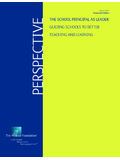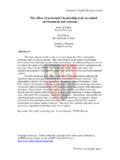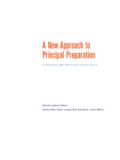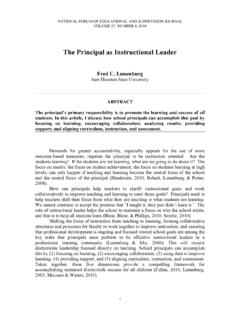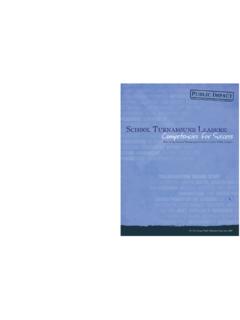Transcription of Instructional Leadership and the School Principal: A ...
1 1 Leadership and Policy in Schools, 4:1 20, 2005 Copyright Taylor & Francis : 1570-0763 print/1744-5043 onlineDOI: and Policy in Schools, Vol. 04, No. 03, August 2005: pp. 0 0 Leadership and Policy in SchoolsInstructional Leadership and the School principal : A Passing Fancy that Refuses to Fade AwayInstructional LeadershipPhilip HallingerPHILIP HALLINGERC ollege of Management, Mahidol University, Bangkok, ThailandOne lasting legacy of the effective schools movement was the institu-tionalization of the term Instructional Leadership into the vocabu-lary of educational administration.
2 Evidence from other recentreviews of the literature on principal Leadership ( , Hallinger,2001; Hallinger & Heck 1996; Southworth, 2002) suggest thattwenty years later, the Instructional Leadership construct is still alivein the domains of policy, research, and practice in School leadershipand management. Indeed, since the turn of the twenty-first century,the increasing global emphasis on accountability seems to have reig-nited interest in Instructional paper ties together evidence drawn from several extensivereviews of the educational Leadership literature that includedinstructional Leadership as a key construct (Hallinger, 2001, 2003;Hallinger & Heck, 1996; Southworth, 2002).
3 The paper will seek todefine the core characteristics underlying this approach to schoolleadership and management based upon both conceptual develop-ments and empirical investigation. The review will identify thedefining characteristics of Instructional Leadership as it hasevolved, elaborate on the predominant model in use for studyinginstructional Leadership , and report the empirical evidence aboutits effects. Finally, the paper will reflect on the relationship betweenthis model and the evolving educational context in which it isexercised and how this is reshaping our perspective on instruc-tional author wishes to thank Ronald Heck and Ken Leithwood whose own work influ-enced many of the ideas presented in this paper, and who contributed insightful suggestionsfor improving the correspondence to Prof.
4 Philip Hallinger, Executive Director, College of Man-agement, SCB Park Plaza, Bangkok, Thailand. E-mail: Page 1 Monday, August 29, 2005 9:34 PM2 Philip HallingerThe School principal has always been expected to perform a variety ofroles. For example, Cuban (1988) identified the political, managerial, andinstructional roles as fundamental to the principalship. He further con-cluded that principal effectiveness is attained by finding the correct balanceamong these roles for a given School s analysis of the principalship occurred during an era inwhich there had been growing interest in the Instructional Leadership roleof School principals.
5 This interest was stimulated initially by findings fromresearch conducted during the 1970s and 1980s on instructionally effec-tive schools. During the 1980s there had led to a boom in the start-up of Leadership academies devoted to Leadership development for focus on Leadership development in schools was the result ofexternal policy reforms aimed at driving School improvement forward bychanging the practice of School leaders (Barth, 1986; Hallinger & Wimpel-berg, 1992).
6 The main curricular focus in these academies was the effectiveschools model, which typically included major strands on Instructional lead-ership (Grier, 1987; Hallinger & Murphy, 1987; Hallinger & Wimpelberg,1992; Marsh, 1992). Although this development suggested that instructionalleadership was becoming more firmly rooted in the role of School adminis-trators, it was still too soon to determine the longer term outcome. Wouldthe attempts at reform bear fruit or would the new shoots shrivel on thevine?
7 At the turn of the century, the American infatuation with performancestandards has become a global love affair (Leithwood, 2003; Murphy, 2002;Murphy & Shipman, 2003). Principals again find themselves at the nexus ofaccountability and School improvement with an increasingly explicitexpectation that they will function as Instructional leaders. Given thepassage of formal government standards for education through the world,principals who ignore their role in monitoring and improving School per-formance do so at their own risk (Bolam, 2003, 2001; Heck, personal com-munication, 2003; Jackson, 2000; Lam, 2003; Leithwood, 2003; Tomlinson,2003).
8 This is also reflected in the emergence of a new global wave of princi-pal preparation and development programs spawned during the late analyses have found a distinct programmatic emphasis on ensuringthat principals are able to fulfill their Instructional Leadership role (Hal-linger, 2003; Huber, 2003). Preparation for this particular role has beenexplicitly linked to training curricula in government-led efforts in theUnited States (Gewirtz, 2003; Hallinger, 2003; Murphy, 2002; Murphy &Shipman, 2003; Stricherz, 2001a, 2001b), the United Kingdom (Bolam,2003; Southworth, 2002; Tomlinson, 2003), Singapore (Chong, Stott, &Low, 2003), Hong Kong (Lam, 2003), and Australia (Caldwell, 2003; Davis,2003).
9 As often as not, however, even the program developers are Page 2 Monday, August 29, 2005 9:34 PMInstructional Leadership3wondering, just what should we be preparing principals to do as instruc-tional leaders? 1 The purpose of this paper is to address this query. The paper seeks toassess development of the Instructional Leadership role of the School principalover the past twenty-five years. More specifically the paper seeks to identifywhat we have learned about this role from theoretical developments, empiricalstudies, and principal S Instructional Leadership ROLE IN EFFECTIVE SCHOOLSA retrospective assessment of Instructional Leadership yields some generalobservations about how scholars have conceived of this role in the periodsince 1980.
10 First, with its emergence out of the research on instructionallyeffective elementary schools ( , Edmonds, 1979), Instructional leadershipwas conceived as a role carried out by the School principal (Bossert et al.,1982; Dwyer 1986; Edmonds, 1979; Glasman, 1984; Hallinger & Murphy,1985a; Leithwood & Montgomery, 1982). During the 1980 s relatively littlereference was made to teachers, department heads, or even to assistantprincipals as Instructional leaders. There was little discussion of instructionalleadership as a distributed characteristic or function to be was widely disseminated during the 1980 s that principals in instruc-tionally effective schools exercised strong Instructional Leadership ; ergo pol-icymakers in the USA took steps to encourage all principals to assume thisrole in order to make their own schools more effective (Barth, 1986; Cuban,1984, 1988; Hallinger & Wimpelberg, 1992).
